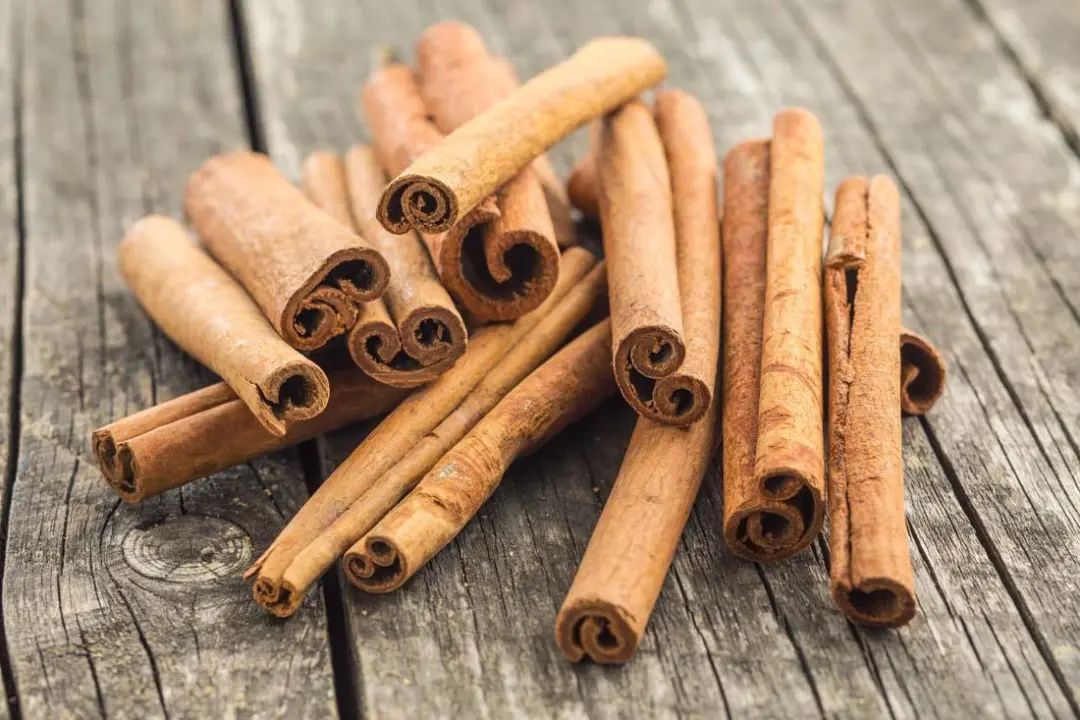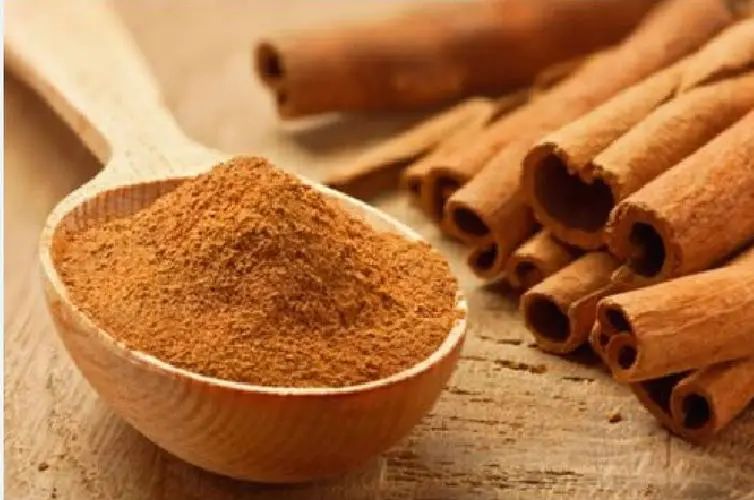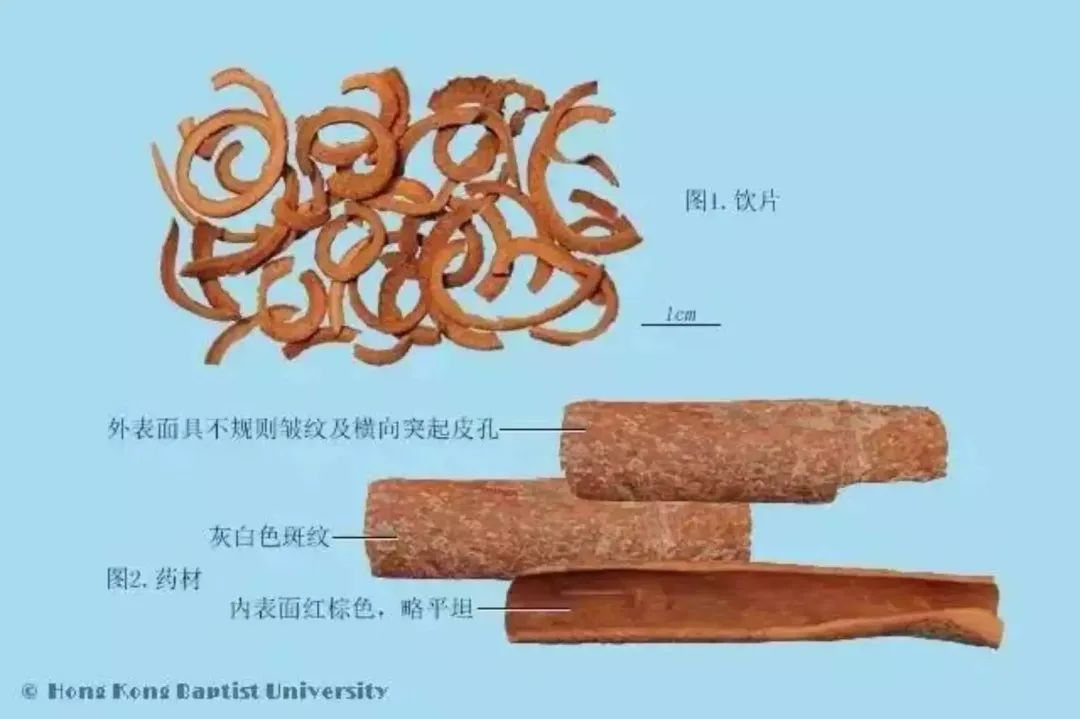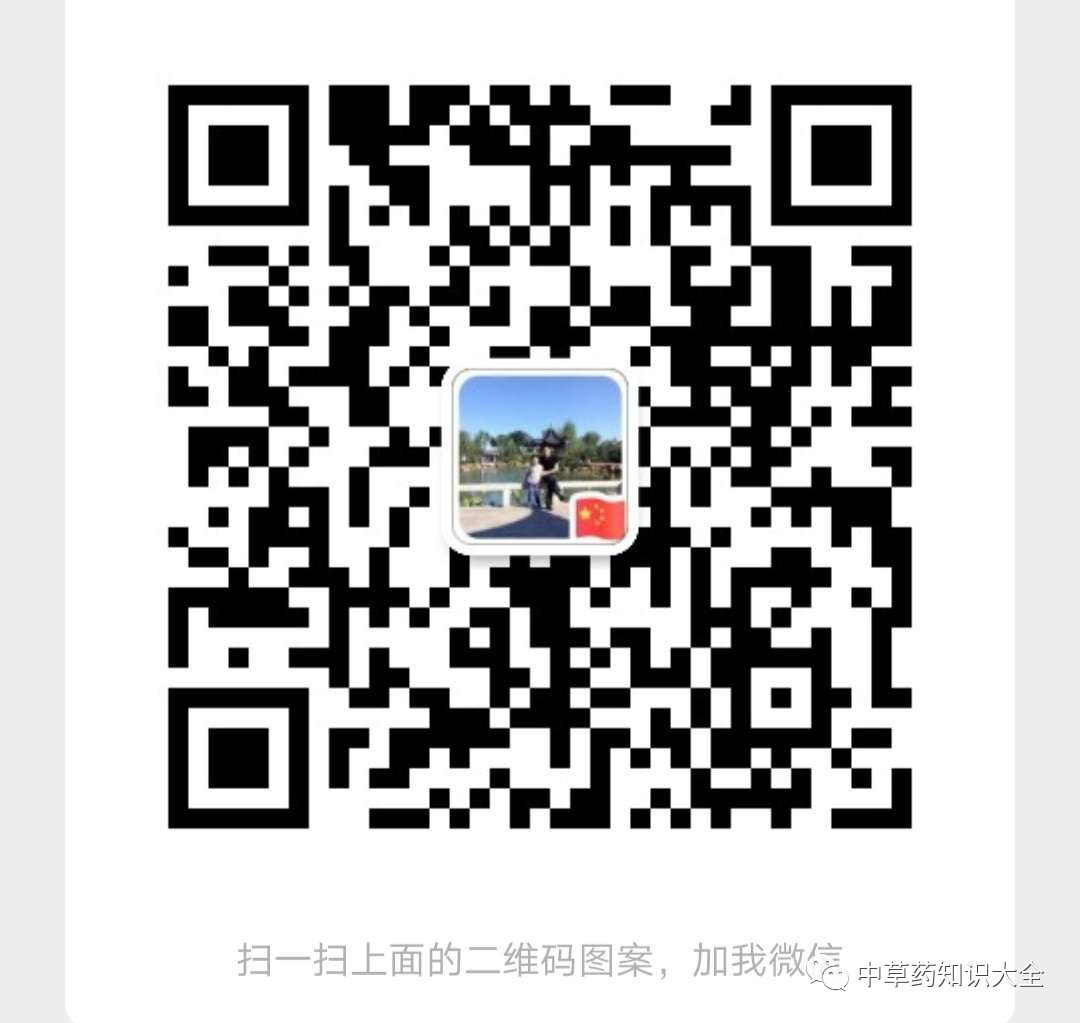Cinnamon is commonly used as a seasoning in meat stews and stir-fried dishes in Chinese households, while in Western countries, it is often ground into powder for flavoring milk tea and coffee. Cinnamon has a unique aroma that is beloved by many. Beyond its role as a spice, cinnamon also possesses significant medicinal value. Consuming an appropriate amount of cinnamon can greatly nourish the organs in the middle jiao (中焦), enhancing their functions. For individuals with poor lung function and symptoms of qi deficiency, consuming cinnamon can help regulate the lungs and improve qi deficiency symptoms. Let’s explore this further.

Cinnamon is also known as Mu Gui (牡桂) in the “Shennong Bencao Jing”, Zi Gui (紫桂) in the “Yao Xing Lun”, Da Gui (大桂) in the “Tang Bencao”, La Gui (辣桂) in the “Renzhai Zhizhi Fang”, Gui Pi (桂皮) in the “Bencao Shu”, and Yu Gui (玉桂) in the “Bencao Qiuyuan”. The medicinal parts are the dried bark and branch bark of the Lauraceae plant, cinnamon.
 The plant is an evergreen tree, growing 12 to 17 meters tall. The bark is gray-brown and aromatic, with young branches slightly quadrangular. The leaves are alternate, leathery; they are elongated oval to nearly lanceolate, measuring 8 to 17 cm in length and 3.5 to 6 cm in width, with a pointed tip and blunt base, entire margins, green and glossy on top, gray-green underneath, covered with fine soft hairs; they have three prominent veins at the base, with fine veins running parallel; the petiole is robust, 1 to 2 cm long. The inflorescence is axillary or near the apex, 10 to 19 cm long, covered with short soft hairs; the flowers are small, about 3 cm in diameter; the pedicel is about 5 mm long; the calyx tube is about 2 mm long, with 6 lobes, yellow-green, oval, about 3 mm long, densely covered with short soft hairs inside and outside; there are 9 stamens in 3 whorls, the anthers are oblong, 4-locular, with the outer 2 whorls lacking glands, the inner anthers facing inward, the 3rd whorl facing outward, with 2 glands at the base of the filaments, and one whorl of degenerated stamens inside, the anthers are heart-shaped; the pistil is slightly shorter than the stamens, the ovary is oval, 1-locular, with 1 ovule, the style is slender and nearly equal in length to the ovary, the stigma is slightly disc-shaped. The berries are oval or obovate, slightly flattened at the tip, dark purple, about 12 to 13 mm long, with persistent calyx. The seeds are elongated oval and purple. The flowering period is from May to July, and the fruiting period is until February to March of the following year.
The plant is an evergreen tree, growing 12 to 17 meters tall. The bark is gray-brown and aromatic, with young branches slightly quadrangular. The leaves are alternate, leathery; they are elongated oval to nearly lanceolate, measuring 8 to 17 cm in length and 3.5 to 6 cm in width, with a pointed tip and blunt base, entire margins, green and glossy on top, gray-green underneath, covered with fine soft hairs; they have three prominent veins at the base, with fine veins running parallel; the petiole is robust, 1 to 2 cm long. The inflorescence is axillary or near the apex, 10 to 19 cm long, covered with short soft hairs; the flowers are small, about 3 cm in diameter; the pedicel is about 5 mm long; the calyx tube is about 2 mm long, with 6 lobes, yellow-green, oval, about 3 mm long, densely covered with short soft hairs inside and outside; there are 9 stamens in 3 whorls, the anthers are oblong, 4-locular, with the outer 2 whorls lacking glands, the inner anthers facing inward, the 3rd whorl facing outward, with 2 glands at the base of the filaments, and one whorl of degenerated stamens inside, the anthers are heart-shaped; the pistil is slightly shorter than the stamens, the ovary is oval, 1-locular, with 1 ovule, the style is slender and nearly equal in length to the ovary, the stigma is slightly disc-shaped. The berries are oval or obovate, slightly flattened at the tip, dark purple, about 12 to 13 mm long, with persistent calyx. The seeds are elongated oval and purple. The flowering period is from May to July, and the fruiting period is until February to March of the following year.
 Meridian Affinities: Kidney; Spleen; Heart; Liver
Meridian Affinities: Kidney; Spleen; Heart; Liver
Taste and Properties: Spicy; Sweet; Hot
Precautions: Contraindicated in cases of yin deficiency with excess heat, internal heat, blood heat leading to bleeding, and in pregnant women. Avoid with red stone resin.
Main Functions and Indications: Tonifies fire and assists yang; directs fire back to its source; disperses cold and alleviates pain; warms the meridians and unblocks collaterals. Indicated for kidney yang deficiency; cold limbs due to waning of the fire at the life gate; soreness and weakness of the lower back and knees; impotence and nocturnal emissions; difficulty or frequency in urination; shortness of breath and wheezing; edema and reduced urination; waning of the fire at the life gate; fire not returning to its source; excess yang; and heat above with cold below; flushed face with cold feet; dizziness and tinnitus; oral and tongue ulcers; spleen and kidney deficiency with cold; cold pain in the abdomen; reduced appetite and loose stools; kidney deficiency with low back pain; cold dampness causing pain; cold hernia pain; cold womb leading to infertility; dysmenorrhea and amenorrhea; postpartum abdominal pain due to blood stasis; yin sores and abscesses; or chronic cold abscesses that do not heal; or after healing, do not close.
Dosage and Administration: For internal use: decoction, 2-5 g, not suitable for prolonged boiling; powdered form, 0.5-1.5 g; or in pill form. For external use: appropriate amount, powdered, for topical application; soaked in alcohol for rubbing.

The Efficacy and Functions of Cinnamon
1. Cinnamon has the effect of warming yang and dispersing cold. In TCM theory, cold evil is a major culprit that causes diseases. As a warming herb, cinnamon can effectively eliminate cold from the body and improve symptoms of cold-related diseases, such as kidney yang deficiency, soreness in the lower back and knees, and cold hands and feet. Additionally, cinnamon helps promote blood circulation, alleviating the sensation of cold extremities.
2. Cinnamon can invigorate the spleen and uplift the spirit. In TCM theory, the spleen and stomach are the foundation of life activities. Cinnamon’s regulating effect on the spleen and stomach is particularly significant, promoting digestion and absorption, enhancing digestive function. Furthermore, cinnamon aids in boosting metabolism, promoting mental, neural, and psychological activity, thus invigorating the spleen and uplifting the spirit.
3. Cinnamon can relieve pain and stop bleeding. In TCM theory, cinnamon has the effect of warming the meridians and dispelling wind, effectively alleviating bodily pain, especially for rheumatic or cold-damp arthritis and lower back and leg pain. Additionally, cinnamon helps stop bleeding and can be used to assist with bleeding symptoms.
4. Cinnamon also has good antibacterial and antiviral properties. It contains a special substance called cinnamic acid, which has excellent antibacterial and antiviral effects. In modern medicine, cinnamon is widely used in the prevention and assistance of viral diseases such as colds and influenza.
5. Cinnamon is also believed to have calming and sedative effects, helping to alleviate stress and anxiety.
Precautions for Cinnamon
Although cinnamon has many benefits, there are also some consumption contraindications. Let’s take a look!
1. Pregnant women should not consume it in excess, as cinnamon contains a high level of cinnamic acid, which may lead to bleeding or premature birth.
2. Berberine and cinnamaldehyde are two components in cinnamon; excessive intake of these may cause liver damage.
3. Ancient texts record that cinnamon is hot in nature and can easily cause excess heat; those with spleen and stomach deficiency and cold should not consume it in large amounts.
4. For individuals on anticoagulant therapy, cinnamon may increase the risk of bleeding.
5. Pay attention to kidney function when consuming cinnamon; individuals with kidney disease are advised not to consume it in large amounts.
 Selected Formulas
Selected Formulas
① For treating kidney qi deficiency, cold in the lower jiao, abdominal pain, frequent urination at night, weakness in the legs, fatigue, dark complexion, lack of appetite; foot qi rising, numbness in the lower abdomen; deficiency and fatigue, thirst for water, heavy and painful lower back, urgency in the lower abdomen, difficulty in urination; diabetes with frequent urination; women with urinary retention: Mu Dan Pi (牡丹皮), Bai Fu Ling (白茯苓), Ze Xie (泽泻) each 3 liang, Shu Di Huang (熟地黄) 8 liang, Shan Zhu Yu (山茱萸), Shan Yao (山药) each 4 liang, Fu Zi (附子, processed, peeled, and pitted), and Cinnamon (去粗皮) each 2 liang. Grind into powder, form into pills the size of a wutong seed. Take 15 to 25 pills with warm wine before meals, twice daily. (This is the Ba Wei Wan from the “Jingui Yaolue”, also known as the Shen Qi Wan from the “Jinkui Yaolue”).
② For treating insufficient yuan yang, waning of the fire at the life gate, cold spleen and stomach, reduced appetite, or nausea and bloating; or stomach upset, or fear of cold, or abdominal pain, or loose stools, frequent diarrhea, or involuntary urination, cold hernia, or cold invading the lower body causing joint pain, or cold in the lower jiao causing water retention, and true yang deficiency with fatigue, palpitations, and inability to gather energy, and yang deficiency leading to infertility: Da Huai Shu Di (大怀熟地) 8 liang, Shan Yao (炒) 4 liang, Shan Zhu Yu (微炒) 3 liang, Gou Qi Zi (微炒) 4 liang, Lu Jiao Jiao (炒珠) 4 liang, Tu Si Zi (制) 4 liang, Du Zhong (姜汤炒) 4 liang, Dang Gui (三两, do not use if loose stools), Cinnamon 2 liang (can gradually increase to 4 liang), and processed Fu Zi 2 liang (can gradually increase to 5 or 6 liang). First, steam the Shu Di until soft, then pound into a paste, form into pills the size of a ball. Chew 2 to 3 pills and take with hot white soup. (This is the You Gui Wan from the “Jingyue Quanshu”).
③ For treating heat stroke, excessive drinking, dampness affecting the spleen and stomach, causing confusion between clear and turbid, yin and yang qi reversing, cholera, vomiting, and organ dysfunction: Gan Cao (甘草, chopped, 30 jin), Gan Jiang (炮炒) 4 jin, Xing Ren (杏仁, peeled and pointed, sand-fried) 4 jin 4 liang, Cinnamon (去粗皮, roasted) 4 jin. First, roast the Gan Cao until 80% cooked, then add Gan Jiang and roast until the ginger cracks, then add Xing Ren and roast until the almonds stop making noise, then sift and grind into powder. Take 2 qian, decoct until 7 parts remain, remove the dregs and take warm. If restless, adjust with well water, and it is also acceptable to take with boiling water. (This is the Da Jiao San from the “Jufang”).
④ For treating chronic cold accumulation, abdominal pain, fullness in the sides, diarrhea, rumbling intestines, spontaneous sweating, and undigested food: Bi Ba (荜茇), Cinnamon each 4 jin, Gan Jiang (炮), and Gao Liang Jiang each 6 jin. Grind into fine powder, boil with water to make a paste for pills, the size of a wutong seed. Take 20 pills with rice soup before meals. (This is the Da Yi Han Wan from the “Jufang”).
⑤ For treating nine types of heart pain, causing oppression: Gui Xin (桂心) half a liang. Grind, take with one cup of wine, decoct until half a cup remains, remove the dregs, and take warm. (This is from the “Sheng Hui Fang”).
⑧ For treating cold hernia, causing intermittent heart and abdominal pain: Gui Xin (桂心) 4 liang, Sheng Jiang (生姜) 3 liang, Wu Zhu Yu (吴茱萸) 2 liang. Cut the three ingredients, use one large sheng of wine, decoct until three cups remain, remove the dregs, and divide into three warm doses. Avoid raw scallions. (This is from the “Yao Sentan’s Collection of Verified Formulas”).
WeChat has been updated! If you neither starred me nor liked or viewed my articles, the system will assume you do not wish to receive updates on herbal knowledge, and ultimately,you will not receive our article updates.
Thank you for your patience in reading. If you find it helpful, please click “like” and “view” at the bottom.
As the saying goes, “In a group of three, there must be a teacher for me.” To facilitate the integration and exchange of knowledge among TCM practitioners, we are preparing to establish a discussion group. If you wish to join, please add the editor on WeChat and specify your identity. The editor invites you to join the group.


